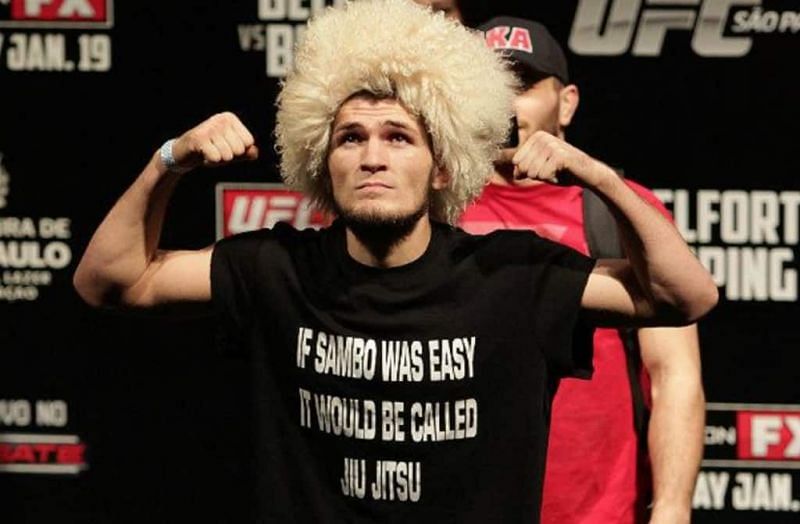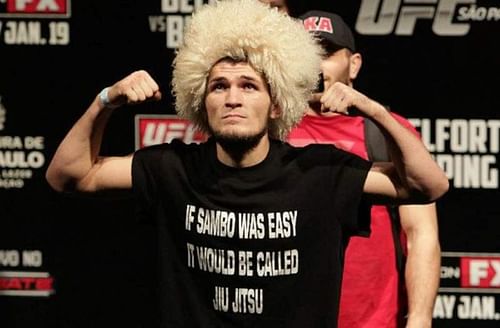
What is Sambo, the martial art that made Khabib Nurmagomedov?

What makes Sambo superior to Brazilian Jiu-Jitsu?
According to recently retired 29-0 legend Khabib Nurmagomedov, it’s the takedowns. The former UFC lightweight champion was widely lauded for his impeccable takedowns throughout his celebrated career.
Brazilian Jiu-Jitsu’s emphasis on leverage and rolling through makes it an on-point martial art when grounded. The problem is, it doesn’t quite provide the best tricks to take a fight to the ground in the first place. In Sambo, Khabib found the perfect blend of standing and floor-based grappling to take his fight game to the next level. Having trained in wrestling, sambo and judo from an early age under his late father Abdulmanap, Khabib’s exceptional chain wrestling made him all but unbeatable by the time he arrived in the octagon.
While many fighters have come from wrestling backgrounds, there are few outside of Russia with much sambo experience. Developed in the early 1920s for the Red Army, Sambo was intended to improve the conditioning and hand-to-hand fighting prowess of Russian soldiers. Recognized by the UWW as a legitimate style of amateur wrestling, Sambo mixes the techniques of freestyle and Greco-Roman wrestling with the joint-locks of Judo. With the addition of a variety of strikes, Sambo has become almost tailor-made for modern mixed martial artists.
Due to its mix of punching, kicking, grappling and emphasis on submissions, Sambo is a well-rounded martial art for those who can stomach the grueling training.
Who else has used Sambo in MMA?
While Khabib has become Sambo’s most famous practitioner in recent years, he is far from the only one. Fedor Emelianenko, widely regarded as one of the most outstanding heavyweights in the history of MMA, is a decorated Sambo champion. Emelianenko has secured gold medals at the World Combat Sambo Federation, European Combat Sambo Federation, All-Russia Sambo Federation and the Combat Sambo Federation of Russia over the years.
Representing his home nation’s sport with pride, Emelianenko (36-9-1) squashed known Sambo critic Chael Sonnen in the first round of their Bellator Heavyweight World Grand Prix Semifinal bout in 2018. Emelianenko last fought in December 2019 where he picked up a round one TKO win over Quinton Jackson.
Former UFC heavyweight champ Andrei Arlovski (31-20-2) is another decorated fighter with a background in Sambo. Taking to martial arts at the relatively late age of 16, Arlovski blended Judo, Sambo and Kickboxing together to form his MMA style. 'The Pitbull' is a former Junior World Sport Sambo champ and holds silver medals in both the World Sambo Cup and World Sambo Championship.
Among the many other fighters who’ve used Sambo to their benefit is UFC Hall of Famer Dan Severn. Often considered a key pioneer in the early days of mixed martial arts, Severn is a Razyrad international master in Sambo.
How difficult is Sambo to master?
The answer is "very." Sambo fighters must display exceptional strength, endurance, mobility and coordination at all times. Training regimens for Sambo are normally chock full of calisthenics, cardio, rolling, grappling, striking and inversion postures such as the headstand and handstand.
Even the professionally undefeated Khabib struggled with Sambo at one point in his adolescence. At just 17, 'The Eagle' made it to the Russian Combat Sambo final where he took on Magomed Ibragimov. Ultimately outmatched by the future 2016 Olympic bronze medallist, the young Khabib was visibly devastated by the loss. Between the painful intensity of the bout and the psychological factor of suffering his first major loss, the future UFC megastar was reduced to tears.
When a martial art reduces the likes of Khabib Nurmagomedov to tears, you know it's not for the faint of heart.
For all the latest news, updates and more from MMA, follow our Facebook page.